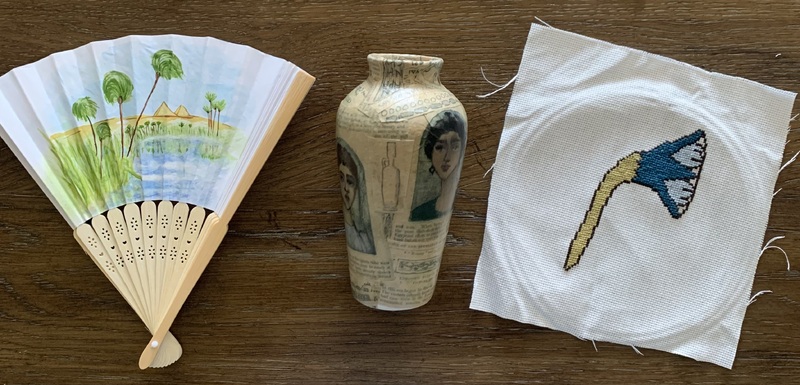Crafting Civilizations: Egyptomania in Nineteenth-Century Girls’ Crafts
From Wedgewood teapots topped with crocodiles to works of popular literature (such as H. Rider Haggard’s She [1887] and Cleopatra [1889], Richard Marsh’s The Beetle [1887] Oscar Wilde's The Sphinx [1894], and Bram Stoker’s The Jewel of Seven Stars [1901]), ancient Egypt’s impact on nineteenth-century aesthetics and print culture was deep. The Victorian's obsession with ancient Egypt is often referred to as Egyptomania, which Eleanor Dobson and Nichola Tonks describe as “the manifestation of enthusiasm for Egypt—in particular, the country’s ancient past—in the cultural consciousness more broadly” (311). Historically, scholars focused on what Victorians Egyptomania tells us about imperialism, orientalism, eroticism, and masculinity. If you are interested in learning more about those topics, I recommend Bradley Deane’s “Mummy Fiction and the Occupation of Egypt: Imperial Striptease” (2008), David Gange’s Dialogues with the Dead: Egyptology in British Culture and Religion, 1822-1922 (2014), Sarah Brio’s “The Shocking Truth: Science, Religion, and Ancient Egypt in Early Nineteenth-Century Fiction” (2018), and Eleanor Dobson’s “Emasculating Mummies: Gender and Psychological Threat in Fin-de-Siècle Mummy Fiction” (2018). Yet, the impacts of Egyptomania on girls’ print culture have largely gone unstudied.
This exhibition explores representations of ancient Egypt in girls’ craft tutorials in the University of Victoria Special Collections's rich nineteenth-century British print material. Included are selected annual volumes of publications The Girl’s Own Paper (January 1880 – 1956) and Atalanta (October 1887 – December 1898). The Girl’s Own Paper was a weekly magazine published by the Religious Tract Society, aimed at lower-middle-class girls, and sold for one penny (Brake and Demoor 249). Atalanta was a monthly illustrated magazine initially edited by L. T. Meade, aimed at upper-middle-class girls, and sold for six pennies (26). This exhibit features articles and/or images from collated volumes of The Girls’ Own Annual and Atalanta rather than individual issues of The Girl’s Own Paper and Atalanta. I remediate articles and illustrations from these periodicals to highlight the influence of ancient Egypt on girls’ print culture.
Using tutorials from late-nineteenth century volumes of The Girl’s Own Annual held by the University of Victoria’s Special Collections as a guide and drawing on a critical making approach, I recreated three craft objects—a ceramic, a painted fan, and a sampler—to demonstrate how these girls’ crafts can be read as active participation in Egyptomania. To the Victorians, crafting was an appropriately feminine domestic activity for girls and young women since crafting was considered part of their education before marriage. The Late Victorian repurposing of crafting to convey historical lessons (as seen throughout this exhibit) could be considered proto-feminist while not agitating the conventional heteronormative culture by encouraging girls to incorporate their interest in ancient cultures into their domestic activities.
Atalanta took a similar ideological approach to its print material overall, publishing articles that educated girls on women’s occupations, education, and opportunities while still educating them on their domestic responsibilities in preparation for marriage. The periodical’s mythological namesake, Atalanta, even captures this theme: the strong huntress promised she would only marry a man if he could defeat her in a race, so Hippomenēs (or Mēlanion) placed golden apples on their path, catching Atalanta when she paused to pick one up. In contrast, The Girl’s Own Paper was aimed at a lower-middle-class audience. This girls’ periodical offered an entertaining but morally acceptable alternative to the popular penny dreadful magazines in which girls might read scandalous stories (Moruzi 85). Therefore, the fact that both Atalanta and The Girl’s Own Paper share a simultaneously exotic and domestic image of Ancient Egypt particularly in association with craft tutorials or articles about crafting, speaks to a shared girl’s culture of the late nineteenth century.
On critical making, Christina Corfield writes, “the act of creating media by hand from scratch using everyday materials holds the potential to be more than just a novelty activity… Learning about how the devices are constructed—which includes choosing themes and images to be visualized by the device—is intertwined with learning about how the devices were situated culturally to promote ideologies through the iconography they contained” (65-67). Even as “explorers” excavated tombs and appropriated artifacts for British museums, handicrafts became acts of domestic museum-making and sources of everyday adventure for readers of these girls’ magazines. Simultaneously examples of the importance of women’s work to the continuation of England’s empire and exercises in imaginative adventures, these crafts invite readers to remix ancient traditions and make them their own, crafting civilizations.
This exhibition is a case study that demonstrates how hands-on learning and analysis reveal wider trends and meaning in Special Collections material. Further research into such trends might consider how nineteenth-century novelists understood, referenced, and parodied girls’ print culture and its obsession with ancient cultures in their work.
Select one of the three crafts (Ceramics, Fan Painting, and Needlework) to learn more about its connection to Egyptomania and view my recreations. Visit the timeline to track the publication of the featured material and key socio-historical events. Click on any image in this exhibit to enlarge it, view its associated metadata, and flip through multi-page articles.
